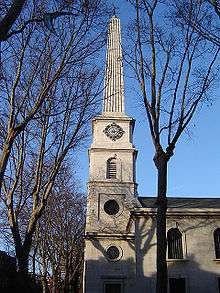St Luke's, London
Coordinates: 51°31′30″N 0°05′35″W / 51.525°N 0.093°W
St Luke's is an area and former civil parish in the London Borough of Islington, just north of the City of London near the Barbican and Shoreditch. It takes its name from the church of St Luke's, on Old Street west of the tube station. The area extends north of the church to City Road and south to Finsbury Square and Whitecross Street.
History
The civil and ecclesiastical parish of St Luke's was created on the construction of the church in 1733, from the part of the existing parish of St Giles Cripplegate outside the City of London.[1]
Being outside the City boundaries, the parish had a large non-conformist population. John Wesley's house and Wesleyan Chapel are in City Road, as is Bunhill Fields burial ground.
In 1751, St Luke's Hospital for Lunatics, an asylum, was founded. Rebuilt in 1782 – 1784 by George Dance the Younger. In 1917, the site was sold to the Bank of England for St Luke's Printing Works producing banknotes and which was relocated in 1958 to Debden in Essex. It was damaged by the Blitz of 1940.[2]
The Grade II Listed Ironmonger Row Baths were built as a public wash house in 1931. Turkish baths were added in 1938.
The civil parish became officially known as "St Luke's Middlesex". The parish was historically in the county of Middlesex, and was included in the area of the Metropolitan Board of Works in 1855. Under the Metropolis Management Act 1855 any parish that exceeded 2,000 ratepayers was to be divided into wards; as such the incorporated vestry of St Luke was divided into five wards (electing vestrymen): No. 1 (12), No. 2 (6), No. 3 (9), No. 4 (12) and No. 5 (9).[3]

From 1889 it was part of the County of London. The vestry administered local government in the area until the civil parish became part of the Metropolitan Borough of Finsbury in 1899. In 1965, this borough was amalgamated with the Metropolitan Borough of Islington to form the London Borough of Islington.[1]
The eponymous parish church is now home to a concert hall and rehearsal space used by the London Symphony Orchestra. The parish has been reabsorbed by St Giles-without-Cripplegate, since the closure of the church.[4]
Whitecross Street Market

Whitecross Street Market is a market with stalls arranged in Whitecross Street and the road closed to traffic. There is a small general market every week day and a larger food market on Thursdays and Fridays, which can be bustling with activity (and queues) on a sunny lunch time. It has occasional food festivals.[5]
The market was formerly one of London's great Sunday markets, and dates to the 17th century; although today, trading is largely limited to lunch times.[6] By the end of the 19th century, the area had become a by-word for poverty and alcohol. It became known as Squalors' Market.[7]
St Luke's Parochial Trust
St Luke's Parochial Trust is an historic charity still operating in the St Luke's area. It has its origins in the gifts of land and money from benefactors to the ancient parish as far back as the 16th century. Nowadays the charity is active in the neighbourhood fulfilling the original charitable purposes of improving the lives of local people. The charity owns and manages a busy community centre on Central Street, from which a wide range of community activities and services are delivered and coordinated.
The community centre was originally the Central Street Board School, one of many Victorian era schools built and managed by the London School Board. The school closed during the Second World War whilst local school children were evacuated to the countryside to avoid the Blitz. The school reopened and operated after the war as the Frank Barnes School for the Deaf until the mid-1970s. St Luke's Parochial Trust purchased the building in 1979, and converted it to a community centre which was opened by the Queen Elizabeth II in 1982.
References
- 1 2 "Old Street St Luke EP Middlesex through time". A vision of Britain.
- ↑ "Institutions with Pauper Lunatics in 1844". Middlesex University resources.
- ↑ The London Gazette Issue: 21802. 20 October 1855. pp. 3891–3893. Retrieved 8 April 2015.
- ↑ Glancey, Jonathan (2003-02-27). "Invasion of the bodysnatchers". The Guardian. London.
- ↑ Whitecross Street Food Festival Matthew Fort, 23 June 2007, The Guardian, accessed 10 Nov 2007
- ↑ London Sunday Trading in Social Investigation/Journalism - Curiosities of London Life, or Phases, Physiological and Social of the Great Metropolis, Charles Manby Smith (1853); accessed 13 April 2009
- ↑ [Squalors' Market] in Social Investigation/Journalism - Unsentimental Journeys; or Byways of the Modern Babylon, James Greenwood (1867); accessed 13 April 2009
External links
- Whitecross Street homepage
- St Luke's Parochial Trust homepage
- Islington Museum and Local History Centre




